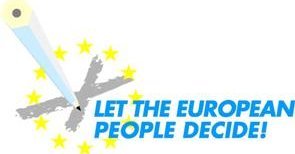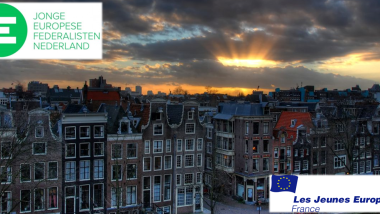However, looking at the amount of signatures collected, the way in which they where collected and where opens several questions and casts some doubts over the success of the campaign.
Some Campaign Facts
17 March 2007: launch of the campaign website (www.europeanreferendum.eu) in Berlin
23 March 2007: MFE and GFE organise a public demonstration in front of the Italian Senate
21 April 2007: official campaign launch at the UEF FC meeting in Munich
16 June 2007: Referendum Day, JEF pan-European action in support of the campaign
Number of signatures collected: > 16.500 signatures
Prominent signatories: Valery Giscard d’Estaign (President of the European Convention), 5 MEPs (Alvaro, Carnero, Frassoni, Geremek, Onesta), Claudia Roth (president of the German opposition party Bündnis 90/Die Grünen) and several Italian senators
Official campaign partners: 17 (in alphabetical order: APEF, Comune di Mignanego, Democratici di Sinistra, DyalogUE Italia, ECAS/European Citizen Action Service, EEU/ Europa Esperanto-Unio, Europa Nostra, Europocket TV, Generation Europe, Il Circolo Europa, International Network for Development, Legambiente, MLS - Movimento Liberal Social from Portugal, Mouvement Démocrate, New Europe, RCE/Women Citizens of Europe Network)
Campaign website in 13 language versions: Catalan, Czech, English, Esperanto, Dutch, Finish, French, German, Italian, Portuguese, Romanian, Slovenian and Spanish.
Political Lessons
Europe needs a constitution and it’s all the European people together who should decide on it! This simple sentence, which is the first thing you see when visiting the campaign website, puts forward two basic federalist claims: the need for a Constitution that would pave the way towards a more federal Europe and the wish to give citizens a direct say in order to achieve a Europe of citizens, thus overcoming the democratic deficit and more importantly the narrow national interest of member states.
Europe needs a constitution and it’s all the European people together who should decide on it!
All this sounds fine in theory and something a rare few (at least among the federalists) would disagree with. The situation gets a bit trickier when we get into the details of the proposal and the actual petition text, which states: I demand a European consultative referendum on the European Constitution, to be held on the same day as the elections to the European Parliament in 2009.
This phrase incorporates several potentially problematic points and most of them were actually questioned and criticised both inside the federalist movement as well as outside it. The two outstanding issues were: European consultative referendum and the European Constitution.
We have to admit that the federalist movement is quite split on the question of direct democracy and the reluctance of some members to support this idea presented the first obstacle to the campaign. On the other hand, some hard core defenders of the referendum method would object to the word consultative, as they would claim that it has to be a binding one.
The second issue was all about which text we actually want to be submitted to this EU-wide referendum. Given the French and Dutch no to the draft Constitution (actually a Treaty establishing a Constitution for Europe) some were very much bothered by the article the instead of a Constitution in the demand. Moreover, this problem intensified after the June European Council decided to water down the text elaborated by the European Convention and subsequent IGC by scraping all constitutional elements and renaming it into a so-called Reform Treaty. Does this mean the campaign is over?
Conclusion
I see two possibilities for the future of the Referendum Campaign: either the federalists decide to follow the line of direct democracy, focus solely on the method of ratification and join forces with the likes of Bonde (www.x09.eu) in demanding an EU-wide referendum on any Treaty change; or we use the successful web-tools developed for signature collection by rephrasing and reframing the campaign into a constant web-platform where we collect signatures for a European Constitution sometime in the future. This second option could be elaborated further by demanding a new Constitutional Convention.
However, the most important question and challenge for the federalists remains striking the balance between political reality and our federalist’s demands, and in this context the balance between fighting for democratic institutional reforms and efficient policy-making, as well as designing what kind of policies we would like to see at the European level …and how these should look like.



Follow the comments: |
|
